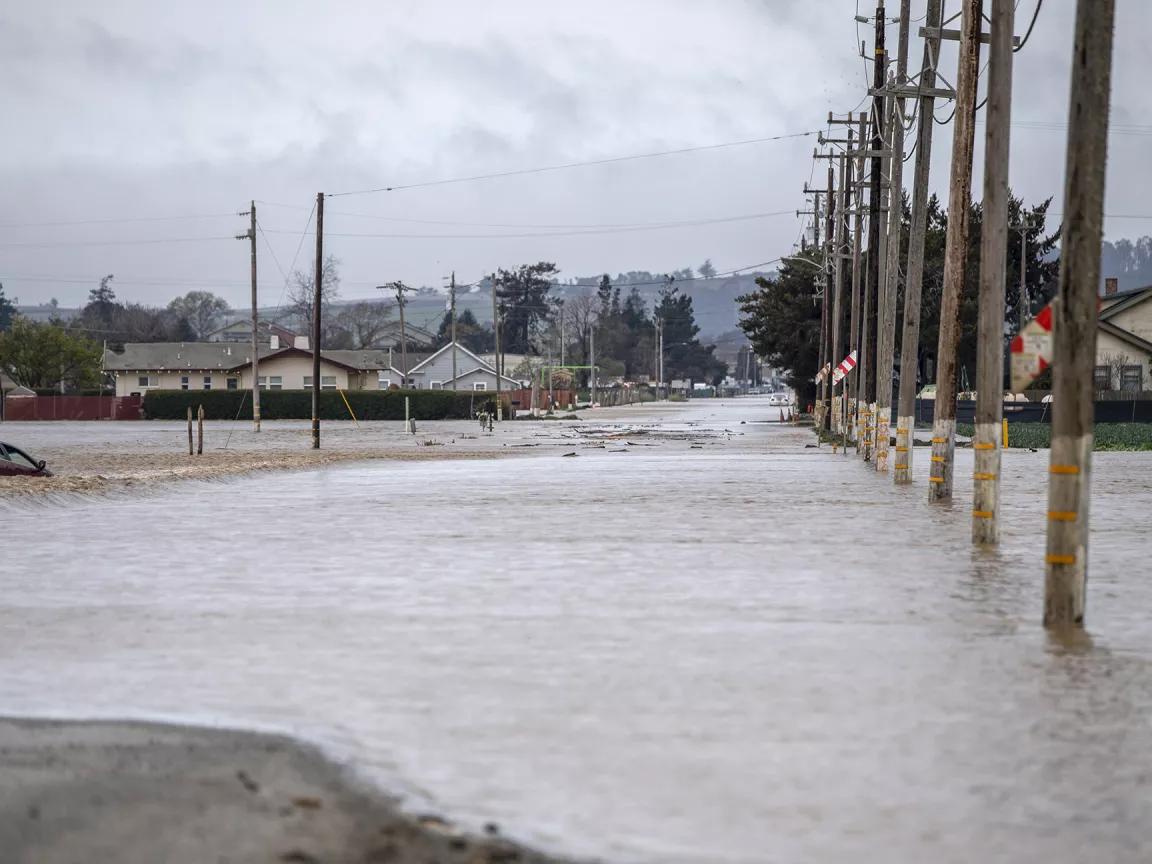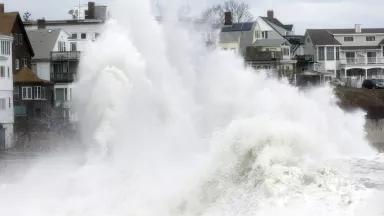How to Survive a Flood
Be prepared for the next major storm by planning ahead and staying vigilant when floodwaters arrive.
When it comes to storms, water is more deadly than wind. It floods homes and businesses, swamps roads, stalls vehicles, and strands people, often with little warning.
This year saw record-breaking rains all over the country, particularly in places that aren’t necessarily known for flooding. In California, atmospheric rivers led to floods and unprecedented snowpack, which brought more floods come spring. Tropical Storm Hilary—the first such storm to hit the West Coast in 84 years—broke rainfall records in Idaho, Montana, Nevada, and Oregon. That same week, Tropical Storm Harold inundated the Gulf Coast of Texas, a state where one in five people live within a designated floodplain. In the Northeast, catastrophic flooding hit Vermont, New York, and Pennsylvania, where one small town received a whopping seven inches of rain in less than an hour. A resulting flash flood swept away 11 cars and killed seven people, including two small children.
As a warming climate intensifies precipitation and expands floodplains, the storm risks we face are also changing, and conventional wisdom (and levels of preparation) may no longer apply. For instance, some people might shrug off a Category 1 hurricane as no big deal because they’ve experienced such storms in the past without issue. What they may not realize is that the rating system the government uses to categorize the severity of storms is based solely on wind speed, not rainfall. Even unrated storms can unleash lethal amounts of water.
So, just as our federal, state, and local authorities need to adjust their storm responses and planning in the era of climate change, so must we shift our mindsets. Everyone—wherever they may live—needs a solid understanding of what to do and how to make quick decisions in the face of rising water. Here are a few basic tips to help you form a plan that suits your personal needs and situation.
Before the Storm
Sign up for alerts.
All major phone providers participate in wireless emergency alerts, which include local text alerts sent by the National Weather Service. Your phone settings likely label them as “government alerts,” “emergency alerts,” “public safety alerts,” or something similar, so make sure to turn them on to get local advisories for incoming bad weather. FEMA, the Weather Channel, and WeatherUSA also have phone apps that can send real-time weather alerts to you. The app from FEMA (the Federal Emergency Management Agency) can help you locate emergency shelters in your area, so make note of them should you ever need one.
Don’t have a smartphone? Ask local officials or search online to see if your city or town has its own emergency alert system. For example, Alert LA County for Los Angeles, NOLA Ready for New Orleans, and Notify NYC for New York City have options for getting alerts via telephone calls. A battery-operated NOAA band radio would also come in handy in the event that internet and cellular services go down.
Get flood insurance.
According to FEMA, just one inch of floodwater can cause up to $25,000 in damages, yet homeowner and renter insurance policies typically do not include coverage for flood damages. Flood insurance must be purchased separately, either through a private insurance company or FEMA’s National Flood Insurance Program.
If your property is located in a Special Flood Hazard Area and you have a mortgage with a bank, flood insurance is likely mandatory. But even if your home isn’t in an area that FEMA identifies as “high risk,” your home could still be very vulnerable. Plus, FEMA flood zone maps are often outdated and fail to take into account the effects of climate change, like sea level rise.
Pack a go bag.
Getting an emergency pack ready in case you must leave home in a hurry can be crucial. This precaution may take a bit of planning, but it helps ensure you won’t forget any essentials in the chaos of the moment and it may save you precious minutes when you need them most. Ready.gov has an extensive list of what to pack, but below are some basics:
- Three days’ worth of drinking water (a gallon per person per day) and/or a water filter
- Three days’ worth of nonperishable food (plus pet food, if necessary)
- Medications
- Toiletries
- Extra clothes and layers
- First aid kit
- Portable radio
- Extra batteries
- Emergency blanket
- Flashlights, LED lights, or light sticks
- Whistle
- Life jacket
- Copies of any important documents, including relevant medical history (medications, dosages, and your doctor’s contact information), stored in resealable, waterproof bags
- Cash, in case ATMs are not available
- Identification and insurance cards
- Maps of the area (paper ones that do not require internet service)
Store important documents and items with care.
Make digital copies of any important paper documents you have and store the originals and other precious items on high shelves, upper floors, or in resealable waterproof/fireproof bags, containers, or safes. Also, take a video of the inside of your home to help with any potential insurance claims.
Plan ahead for loved ones of all ages and abilities:
- Carry the contact information of nearby family members or neighbors who may need assistance or who could provide you with physical help during a flood.
- If you have a serious health condition, consult with your doctor about an emergency medical plan.
- If you have mobility issues, keep a spare manual wheelchair or other assistance devices (walkers, canes, crutches, etc.) at hand in case you cannot charge an electric wheelchair.
- If driving isn’t an option, reach out to friends, family, or neighbors for a ride somewhere safe.
- Get to know your neighbors and research emergency protocols and services in your area. This can include reaching out to your local fire department as well as community associations, faith-based organizations, or even a neighborhood watch. Check the procedures in place at schools, nursing homes, or workplaces to help you account for any friends and family members during a sudden weather emergency.
- If you have pets, plan ahead for where they’ll go. Note that many animal shelters won’t be able to take them in.
When the Storm Hits
Keep an eye on the news.
Notable terms that may pop up on news alerts include flood watch, flood warning, and flash flood. A flood watch means that flooding might occur, while a flood warning means that it’s already happening or is imminent. A flash flood happens when there is a tremendous amount of rain over a short period of time, usually six hours or less—think of them as surprise floods in which water levels rise very, very quickly.
Move to higher ground.
In a flood, the higher the elevation, the better—especially if you live in a flood-prone area or basement apartment. This could mean moving to the upper levels of your house, apartment building, or another location altogether. But only go onto your roof if absolutely necessary. Do NOT take shelter in a closed attic (one without windows that you can fit through) as you may become trapped if water levels continue to rise.
Be prepared to evacuate:
- If you are able, evacuate when directed to do so by public safety officials.
- Text “SHELTER” and your zip code to 43362 to find the nearest emergency center.
- Before leaving, turn off your utilities (gas, water, and electricity) and unplug all electronic devices.
- For those unable to drive, follow evacuation instructions given by public safety officials and note which public modes of transportation are still available.
- For drivers, fill up your tank with gas or charge your electric vehicle as far ahead of time as possible to avoid long lines and traffic. Also try to park your car in areas less prone to flooding prior to the storm. Use the travel routes recommended by authorities. Do NOT take shortcuts as they may already be impassable or dangerous.
If unable to evacuate, here are some ways to increase safety while sheltering in place:
- If possible, turn off your utilities (gas, water, and electricity) and unplug all electronic devices.
- If trapped by rising waters, get to the highest possible point and call 911.
- Do NOT walk through floods. As little as six inches of rushing water can sweep a large person away, and even in calmer waters, there can be hidden hazards beneath the surface, such as live electrical wires, sewage, or toxic chemicals.
If flooding hits while driving:
- If you come across washed-out roadways, turn around as soon as possible to find an alternate route. Do NOT attempt to drive through flooded roads, as your vehicle could stall, fill with water, or get swept away. Driving into floodwaters accounts for more than half of flood-related deaths.
- Should floodwaters reach your car, get out of the vehicle as soon as possible. Get to higher ground, or if there is too much water to safely walk through (more than a half foot of moving water), climb to the roof of your car and call 911 immediately.
After the Storm
Floodwaters can carry noxious stuff: sewage, toxic chemicals, and runoff from hazardous waste sites and factory farms. They can pollute drinking water supplies, and even when floodwaters recede, dangerous bacteria and mold may remain. As a result, it’s critical to take steps to protect your health when you return after a flood, particularly if you have any standing water in your home. Pay attention to local drinking water alerts, as well as the guidance from the Centers for Disease Control and Prevention here.
This NRDC.org story is available for online republication by news media outlets or nonprofits under these conditions: The writer(s) must be credited with a byline; you must note prominently that the story was originally published by NRDC.org and link to the original; the story cannot be edited (beyond simple things such as grammar); you can’t resell the story in any form or grant republishing rights to other outlets; you can’t republish our material wholesale or automatically—you need to select stories individually; you can’t republish the photos or graphics on our site without specific permission; you should drop us a note to let us know when you’ve used one of our stories.





Sea Level Rise 101
In Planning for Climate Change, Native Americans Draw on the Past
What Is the Justice40 Initiative?